If you want to truly feel you have a place in the gardening world, you need to have viburnums. I feel like the landscape is not complete without at least 1 viburnum, either native or nonnative. Viburnums come in all shapes and sizes, with varying fruiting abilities and sun tolerances.
Similar in variety to hydrangeas, the viburnum has a shorter bloom period, but has added interest with many forms, fruit colors, and fall foliage. There are even a few with edible berries. You can and should add some to your landscape, if you have not already done so.
Growing Viburnums
Even though some of the species can handle more shade than others, they all do their best in full sun, with at least 6 hours of light. The various species of viburnums are similar in water requirements too, and all are drought and heat tolerant. Plant viburnums in well-drained soil for best growth, but know that they can handle heavy clay as well.
Pests of Viburnums
There are hardly any insect or animal pests on the nonnative viburnums grown in the Central Great Plains and Midwest. However, our native species have native insect problems, though these are also few in number.
Problems that you may find on your viburnums can include leaf beetles, aphids, plant bugs, treehoppers, and occasional borers. Also, caterpillars of 11 species of moths, and those of the spring or summer azure butterflies may feed on the leaves and/or flowers.
The viburnum leaf beetle is a potential threat to the plant, but can be easily dealt with by chemical sprays of spinosad or bifenthrin. Be sure to identify the pest before applying any chemical in the garden.
Diseases of Viburnums
While there are a handful of diseases affecting viburnums, none are life threatening without secondary infections from insect pests. Powdery mildew, leaf spots, downy mildew, and cankers are all possible, but rarely devastating. Planting viburnums in full sun, away from sprinklers, will prevent many on these diseases.
Viburnums for Pollinators
Even though viburnums do not bloom for a very long time, they are visited by a number of pollinators. While butterflies and moths do occasionally visit the flowers, they are most often frequented by various hover flies, tachinid flies, dance flies, beetles, long-tongued bees, and halictid bees.
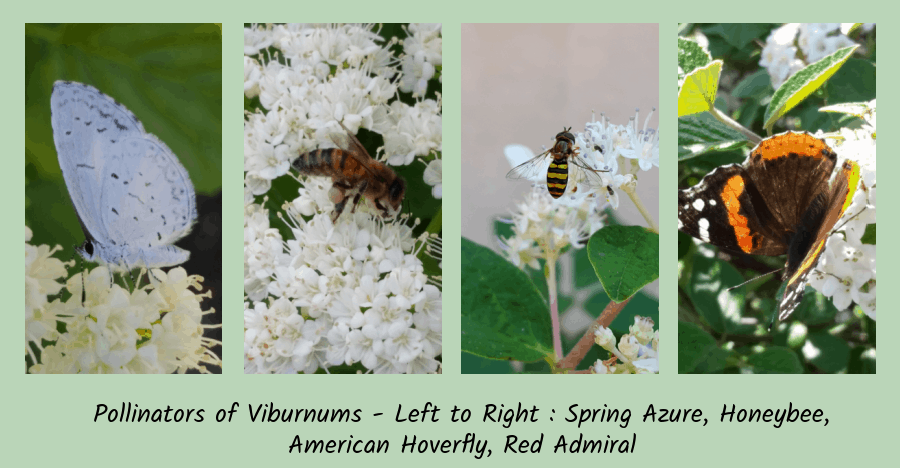
Choosing a Viburnum for Your Garden
When you are picking out a viburnum to put in your own garden, have a spot in mind. And be ready to let it do its thing. While I do not deny that many shrubs can be sheared for a tight look, I do not recommend shearing because it is not healthy for the plant. Let plants grow and prune only when extremely necessary.
Also, when choosing a viburnum, you will need to decide between native and nonnative species. I have found many reasons to have both in my gardens. Let us take a look at some of the different viburnums for the Central Great Plains and Midwest regions, hardy to at least Zone 5.
Native Viburnums
Arrowwood (V. dentatum)
One of my all-time favorite shrubs, the arrowwood is native across Southeastern United States. In the garden, the arrowwood is a very durable and can be used as a screen, hedge, or in individual clumps in a bird-lover’s garden. If left to grow, plants may reach 15 feet tall and wide.
The spring flowers are white, and considered to be strong-smelling, or unpleasant to most, but I rather like it. Blue-black berries follow the flowers and are generally left alone by birds until late winter. The fall foliage is excellent, reds and oranges. I recommend any of the following cultivars for the garden.
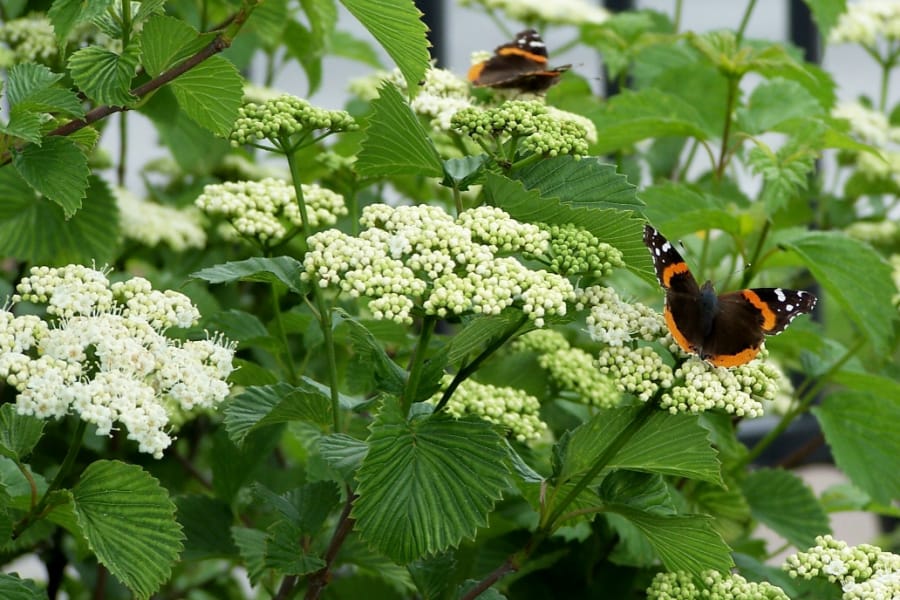
‘Blue Muffin’ – grows 7 feet tall by 5 feet wide with dark blue fruits. It blooms earlier than the species. In my own gardens, I have several ‘Blue Muffin’ viburnums scattered about, in both full sun and part shade.
‘Red Feather’ – has red-purple emerging growth, and turns a brilliant burgundy in autumn. It grows 10 feet tall and wide at maturity.

Nannyberry (V. lentago)
If you are looking for a tall hedge-shrub to plant between you and the neighbors, and has edible fruit, look no further than the nannyberry. Growing even as tall as 50 feet, it averages around 20 feet tall by 15 feet wide. There is a hedge in one of my customers’ landscapes that is 100 feet long, 10 feet tall and 5 feet wide.
Native to the Upper Midwest and Northern Great Plains, this cold hardy viburnum has shiny green leaves, creamy white flowers, and burgundy to purple fall foliage. The berries are borne in large clusters and are sweet and tangy. I like to pick the berries off the plants in my garden and pop them right into my mouth.
There are no significant cultivars, but who needs them with the greatness of the species alone?
American Cranberry-bush (V. trilobum)
Virtually indistinguishable from the European Cranberry-bush (V. opulus), this species is a great addition to the garden. With white, lace-cap flowers and edible red fruits, it is a must have in the garden. It grows 12 feet tall and wide, and can handle full sun from Zones 2 to 5, but needs part shade in locations farther south.
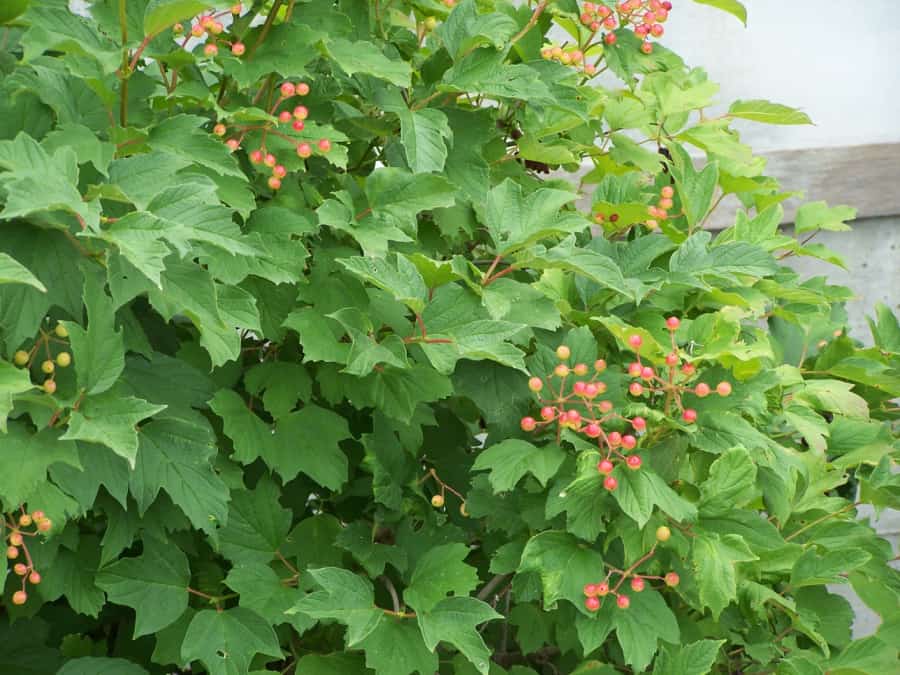
The fall foliage of American cranberry-bush is burgundy red to purple, very showy. Showy red fruits which hang in large clusters, can be used to make jelly or wine. The best known cultivar is ‘Redwing’ which has reddish new growth, and grows 12 feet tall and wide.

Blackhaw (V. prunifolium)
Native to the Southeastern U.S. and Southern Plains (including Kansas), this viburnum can handle full sun or part shade. Indeed, the wild species I have found nearby were in almost full shade. It can be pruned to grow as a tree, up to 30 feet tall and 25 feet wide. Shrub forms often mature around 15 feet tall and wide. Fall foliage is burgundy.
Blackhaw is another native viburnum with edible fruit. The almost black berries ripen in autumn and are loved by birds and gardeners alike. The leaves resemble those of the black cherry, which is the reason for the species name of prunifolium (prunus is the genus of cherries). Older specimens may have blocky bark, similar to persimmons.
Nonnative Viburnums
Burkwood Viburnum (V. x burkwoodii)
A cross between two other viburnums, this is one of Michael Dirr’s favorite species. It is perhaps one of the most fragrant of all viburnums. The flowers have a sweet and spicy aroma, similar to cinnamon and nutmeg scents. Flowers are white and pink, and the foliage is shiny green, turning purple-red in autumn. Blue-black fruits are favored by birds.
Mature specimens can reach 15 feet tall and wide. They grow well in full sun to parts shade, and are adaptable to a wide range of soils. There are 3 excellent cultivars for our gardens.
‘Conoy’ – grows 8 feet tall and wide, with narrow, shiny green foliage. Pink buds open to white, but the flowers lack the fragrance of the parent. A great shrub for hedges and screens.
‘Mohawk’ – is possibly the most fragrant of all the Burkwood hybrids. The flower scent is heavenly and the flowers are quite abundant. Fall foliage is burgundy to red. The plants grow 10 feet tall and wide.
‘American Spice’ – from Bailey Nurseries, is a compact form, growing just 5 feet tall and wide. Fall color is purple with yellow and orange overtones. The fragrance is spicy and sweet.
Korean Spice (V. carlesii)
Another very fragrant viburnum, this is my favorite of the nonnatives. I love the heavenly fragrance of these shrubs. And they are easy to find and use in the garden. Rounded in shape, the species grows up to 12 feet tall and wide. They prefer full to part sun, but flower best in full sun. Korean spice viburnums are hardy in zones 4 to 8 and grow well in heavy clay and high pH soils, but are adaptable.
Fall foliage is a mix of purple, orange, red, and yellow. It can be used as a hedge, screen, specimen or focal point, or in masses along a shrub border. I have mine mixed into my shrub border around the property, with other shrubs such as mockorange, arrowwood, hazelnut, spicebush, and ninebark.

‘Compactum’ – grows 3 to 4 feet tall and wide with dark green leaves and large flowers. It is mostly resistant to bacterial leaf spot. This is the cultivar I first learned about at Kansas State University.
‘Spice Baby’ – is a Proven Winners selection that grows 5 feet tall and wide. I have this selection growing in my shrub border. Rabbits do eat the stems in late winter, so provide some protection until your shrub outgrows them.
‘Spice Girl’ – is another Proven Winners selection, but it grows 7 feet tall and wide. Pink buds open to white flowers.
Judd Viburnum (V. x juddii)
A cross between V. carlesii and V. bitchiuense, this is another fragrant viburnum like the Burkwood. In fact, it is often referred to as the Fragrant Viburnum. The flowers are semi-snowball shaped, with very good fragrance. Specimens generally grow 8 feet tall and wide. It is hardy in zones 4 to 8.
Wayfaringtree Viburnum (V. lantana)
It does seem like quite a name for any plant. The leaves of this shrub are semi-evergreen, even in zones 5 and 6. However, the species has mostly been replaced by cultivars and crosses. It grows 15 feet tall and wide, making it excellent for screening and hedges.
‘Mohican’ – is the main cultivar that is easy to find in nurseries. Consistently deciduous, it is resistant to leaf spot and has good orange-red fruits. Size is 9 feet tall and wide.
Japanese Snowball (V. plicatum var. plicatum)
The Japanese snowball viburnum is one of the showiest spring flowering shrubs, which has long been used for cut flower arrangements. In my grandmother’s garden in North Central Kansas, this was the only viburnum she had. The flowers are sterile and shaped roughly as a snowball.
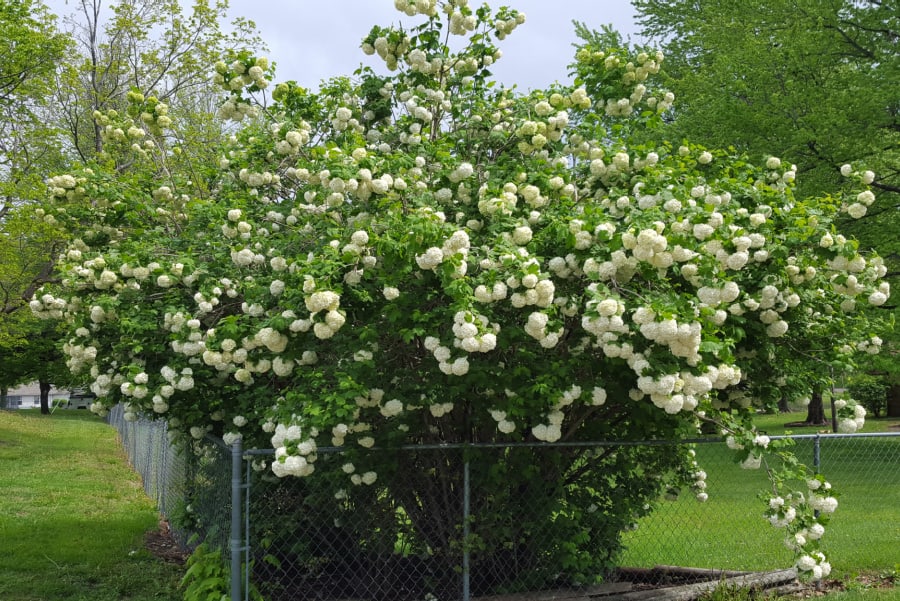
This shrub can get quite large if grown in full sun, up to 12 feet tall and wide. In part shade, it stays at a more moderate height of 6 feet tall and wide. There are several cultivars that are great additions to the garden.
‘Popcorn’ – has the best habit of older cultivars, growing 9 feet tall and wide with leathery, dark green leaves. The flowers are brilliantly white and very showy.
‘Opening Day’ – is a newer selection with a rounded form, growing 8 feet tall and wide.
Doublefile (V. plicatum var. tomentosum)
The doublefile viburnum is my favorite viburnum for shade. I have a seedling that has made 2 moves since I pulled from a landscape in Topeka. Now, it is a large, well-shaped shrub in the center of my Entry Garden. With horizontal branching structure, it is one of the best small trees for the garden.
The flowers are lacecap, and there are many cultivars to choose from. Fall foliage is dark red to purple, and is can be shaped into a small tree, or trimmed as a shrub. Red to black berries follow the flowers and are scooped up readily by birds. This viburnum matures around 15 feet tall and wide.
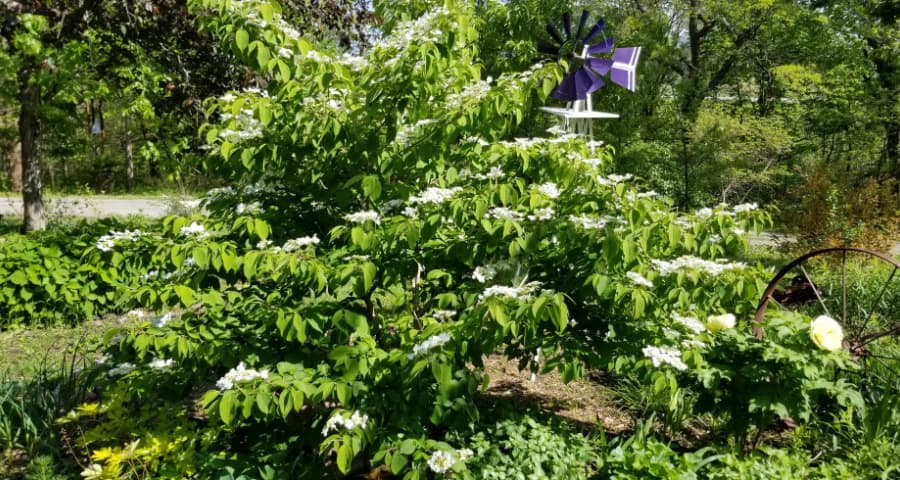
‘Summer Snowflake’ – a repeat blooming viburnum, rare in most cases. However, just like repeat blooming daylilies, the secondary blooms are not as showy and tend to be centered in the plant, not on the edges. It grows 8 feet tall by 5 feet wide, a very narrow selection.
‘Mariesii‘ – also known as Marie’s doublefile, this selection is quite showy, just like the species. It grows 10 feet tall and wide.
‘Pink Beauty’ – if you can find this one let me know, I’d love to add it to my garden. It grows 10 feet tall and wide with light pink flowers, instead of white. Fruits are bright red.
Leatherleaf Viburnum (V. rhytidophyllum)
The leatherleaf viburnum is a great shrub for sun or shade, and can be used as a screen or hedge. Here in the Central great Plains, it retains its leaves through the winter, though they often turn a brownish-green. The narrow leaves add good texture. Flowers are creamy-white and not fragrant, though they do attract hover flies. It grows 12 feet tall and wide.
NOTE: Some nonnative viburnums are listed as invasive. Please check with your local extension agent or government authority before planting nonnatives. Some included as invasive are V. opulus, V. dilatatum, and V. lantana.
Companion Plants for Viburnums
When you are developing your garden and adding viburnums, it would be nice to have some other shrubs that mix well with them. Viburnums can stand alone in the garden, with perennials and grasses nearby, but there are other shrubs that everyone should grow as well.
Ninebarks – these easy to care for shrubs come in a wide range of leaf colors, sizes, and new growth colors. I have 5 cultivars of ninebarks in my gardens and I love each one of them. Try ninebark ‘Amber Jubilee‘ paired with viburnum ‘Cardinal Candy’.
Oakleaf Hydrangea – I can think of no better shrub for full shade and which also works in full to part sun. With multiple season interest, the oakleaf hydrangea is both beautiful and functional in the garden. Pair oakleaf hydrangea ‘Alice’ with doublefile viburnum ‘Mariesii’.
Chokeberry – these versatile native shrubs can grow in full sun to part shade and have excellent flowers, edible fruits, and great fall foliage. The leaves are shiny green in summer. Pair chokeberry ‘Viking’ with blackhaw viburnum.
Mockorange – this is one of the most fragrant flowering shrubs out there. Unlike the spicy aroma of the Korean Spice viburnum, mockorange has a sweet smell. Pair the 2 shrubs together for a fragrant punch in spring.
Conclusion
Viburnums are without a doubt, the most iconic shrub for the garden. With species and cultivars from North America, Asia, and Europe, it is easy to find one to suit you and your garden. If you only have one that is great. If you are like me, then you may have at least 10 species or cultivars mixed across the landscape. However many you have, they will be special.
Happy planting!
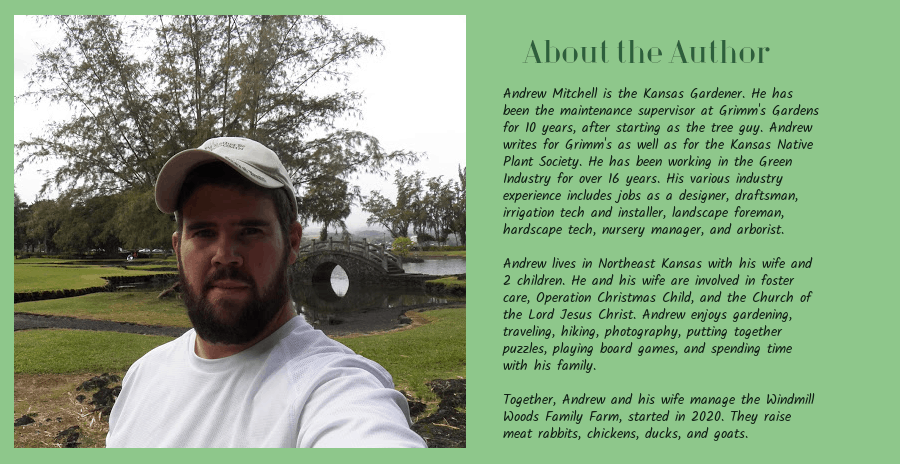




If I was going to try to plant a hedge of Nannyberry Viburnum like the one you mentioned that is 100′ long, 10′ high and 5′ wide, how far apart would you plant them, 10ft? Is it one row or like 2 rows, staggered?
Thanks,
Here’s a mystery for you. My Blue Muffin Viburnum has berries. I wasn’t expecting that because I do not have a second plant to pollinate it. Is it remotely possible that it was cross-pollinated by my elderberry plants? There aren’t any other nearby viburnums so I have no idea how it got berries. Thanks!
E
My blue muffin is full of berries this year. I planted it two years ago. I also have elderberry and a number of unknown viburnum hybrids that get red berries. I have Blackhaw and arrowwood native viburnums but they are small and not blooming. Is a mystery to me but very lovely berries on blue muffin and now pink in color as they start to turn.
Missing some of my favorites. Raulston Hardy is a gorgeous small viburnum. Mine are currently showing off masses of flowers.
Hi Anita, thank you for your comment. Unfortunately, I could not list all the viburnums. These are the best for the Central Great Plains Region, and I am sure there are cultivars I have missed. The important part is that we need viburnums in our gardens. I am glad to hear that you have some interesting species in your garden.
Question: My beautiful viburnum trillium compactum, about 10 years old, took a bad hit during our late-summer drought here in RI. Most of the leaves turned black, though a few lonely branches retained their leaves and dropped them in the fall, as usual. Will it come back next spring? Should I leave it alone or cut back dramatically (it’s about 7 feet tall – very lush until last summer). Thank you!
Hi Fred,
I am sorry to her that you have had severe drought, much like us. In regards to your question about your viburnum. I would wait and see if it does come back this spring before doing anything. If you are still dry this winter (no snow or rain), then water it anytime the ground is thawed and temps above freezing at night.
If it does indeed come out this spring, do not trim it back. Cutting a distressed shrub like a viburnum back will put pressure on the root system to regenerate enough leaf mass to support photosynthesis. It needs those to survive. I would recommend watering when necessary, if possible, and putting organic compost/worm castings underneath it starting 12 inches away from the trunk and extending outward 3 feet. If it is not mulched, then do so on top of the compost. Leaf mold, finely shredded bark, or pine straw are the best mulches.
Thank you,
The Kansas Gardener